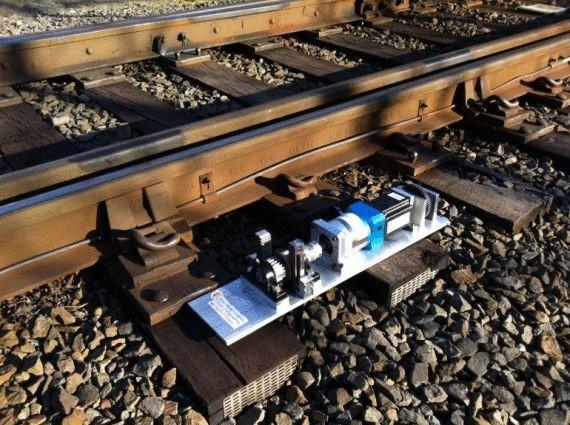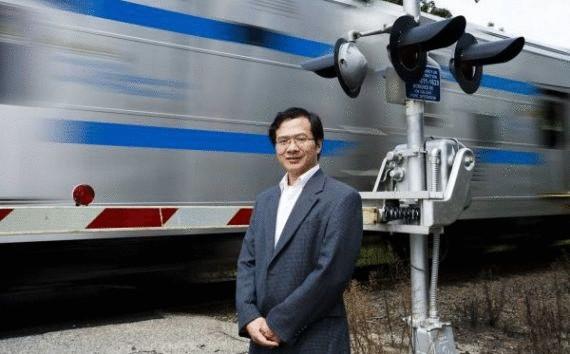531
The transformation of the vibrations of rails into electrical energy
Researchers have developed and patented a device that can convert the vibrations of rails into electrical energy.
Moving on rails, wheels put pressure on them and cause vertical oscillatory movement. Scientists have created an energy collector, which, using the irregular movement of the rail, able to generate enough power to operate railway equipment such as switches, arrows, system control and indicating light.
Such devices are effective for energy absorption in case of a regular unidirectional movement, while the rails are fluctuating up and down. Collector, developed by a team of researchers at the University of stony brook, is able to convert the oscillatory vibration of the railway track in the regulated unidirectional rotational motion, similar to the rectifier makes AC from DC. In the list of inventors Professor, Department of mechanics lei Zuo (Lei Zuo), post-graduate students Gopinath Reddy Penumalli (Gopinath Reddy Penamalli), Tan Lin (Lin Teng) and John Wang (John Wang).

"The US has the longest rail journey in the world, about 140700 miles, which are often deployed in remote areas," says Professor Zuo. "It is very important, but also very expensive to power a remote electric infrastructure, such as signal lights, switches and sensors. Our invention can receive 200 Watts of electrical energy from the displacement of the railway track and nourish the peripheral electric device."
According to Professor Zuo, their technology removes the basic problem of vibration, converting it into unidirectional rotation, which determines the high reliability and efficiency of the energy collector. The flywheel used in the device provides a relatively constant speed of rotation, reducing mechanical stress and increasing reliability. Bench tests of the prototype conducted by scientists revealed that the energy conversion efficiency ranges from 55 to 72%.

Professor lei Zuo believes that the introduction of their invention can save tens of millions of dollars spent on peripheral station devices, and at the same time reduce carbon dioxide emissions by 3,000 tons annually.
The invention of scientists from stony brook has been awarded "Best device for the Assembly of energy" at the 3rd conference of energy harvesting and wireless sensor networks (Energy Harvesting and Wireless Sensor Networks USA), held in Washington on 7-8 November this year.
Source: /users/276
Moving on rails, wheels put pressure on them and cause vertical oscillatory movement. Scientists have created an energy collector, which, using the irregular movement of the rail, able to generate enough power to operate railway equipment such as switches, arrows, system control and indicating light.
Such devices are effective for energy absorption in case of a regular unidirectional movement, while the rails are fluctuating up and down. Collector, developed by a team of researchers at the University of stony brook, is able to convert the oscillatory vibration of the railway track in the regulated unidirectional rotational motion, similar to the rectifier makes AC from DC. In the list of inventors Professor, Department of mechanics lei Zuo (Lei Zuo), post-graduate students Gopinath Reddy Penumalli (Gopinath Reddy Penamalli), Tan Lin (Lin Teng) and John Wang (John Wang).

"The US has the longest rail journey in the world, about 140700 miles, which are often deployed in remote areas," says Professor Zuo. "It is very important, but also very expensive to power a remote electric infrastructure, such as signal lights, switches and sensors. Our invention can receive 200 Watts of electrical energy from the displacement of the railway track and nourish the peripheral electric device."
According to Professor Zuo, their technology removes the basic problem of vibration, converting it into unidirectional rotation, which determines the high reliability and efficiency of the energy collector. The flywheel used in the device provides a relatively constant speed of rotation, reducing mechanical stress and increasing reliability. Bench tests of the prototype conducted by scientists revealed that the energy conversion efficiency ranges from 55 to 72%.

Professor lei Zuo believes that the introduction of their invention can save tens of millions of dollars spent on peripheral station devices, and at the same time reduce carbon dioxide emissions by 3,000 tons annually.
The invention of scientists from stony brook has been awarded "Best device for the Assembly of energy" at the 3rd conference of energy harvesting and wireless sensor networks (Energy Harvesting and Wireless Sensor Networks USA), held in Washington on 7-8 November this year.
Source: /users/276























